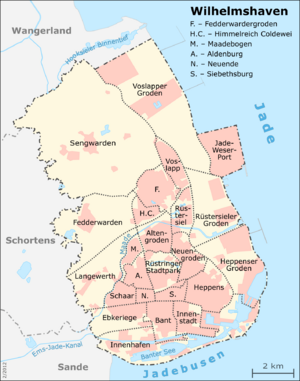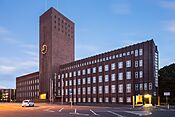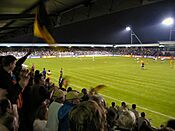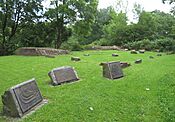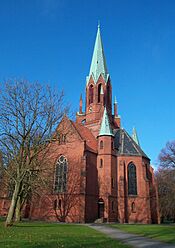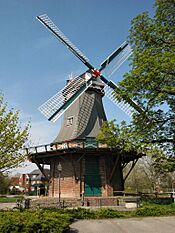Wilhelmshaven facts for kids
Quick facts for kids
Wilhelmshaven
|
||
|---|---|---|
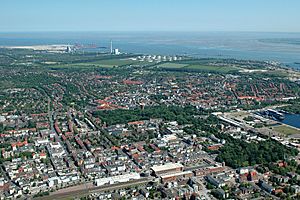 |
||
|
||
| Country | Germany | |
| State | Lower Saxony | |
| District | Urban district | |
| Elevation | 2 m (7 ft) | |
| Population
(2022-12-31)
|
||
| • Total | 76,089 | |
| Time zone | CET/CEST (UTC+1/+2) | |
| Postal codes |
26351–26389
|
|
| Dialling codes | 04421, 04423, and 04425 (each partially) | |
| Vehicle registration | WHV | |
| Website | www.wilhelmshaven.de | |
Wilhelmshaven is a city on the coast in Lower Saxony, Germany. Its name means "Wilhelm's Harbour". It is located on the western side of the Jade Bight, which is a bay of the North Sea. The city has about 76,000 people living there.
Wilhelmshaven is a key place for business in the "Jade Bay" area. It is also Germany's most important military port. The nearby Lower Saxony Wadden Sea National Park is a special place. It is part of the Wattenmeer UNESCO World Natural Heritage Site. This park helps bring many tourists to the area.
Contents
History of Wilhelmshaven
Early Times and Founding
Before 1383, there was a castle called Siebethsburg here. It was used by pirates. The Hanseatic League, a group of trading cities, destroyed it in 1433.
Many years later, in the 1800s, the Kingdom of Prussia wanted a port on the North Sea. In 1853, Prince Adalbert of Prussia made a deal called the Jade Treaty. The Grand Duchy of Oldenburg gave Prussia about 3 square kilometers of land. This land was on the Jade Bight.
In 1869, King William I of Prussia officially started the city. He later became the German Emperor. Wilhelmshaven was a special area, separate from the rest of Prussia. It became a naval base for Prussia's growing fleet. The land around the city remained part of Oldenburg.
A large shipbuilding yard was built in Wilhelmshaven. It was called the Kaiserliche Werft Wilhelmshaven, or "Wilhelmshaven Imperial Shipyard". On June 30, 1934, a famous ship called the Admiral Graf Spee was launched here. It was a type of warship known as a "pocket battleship."
In 1937, Wilhelmshaven joined with the nearby village of Rüstringen. The new, bigger city was still called Wilhelmshaven. It became part of the Free State of Oldenburg.
World War II and After
During World War II (1939–1945), Wilhelmshaven was the main base for the German navy, called the Kriegsmarine. The Allied forces bombed the city heavily. About two-thirds of the buildings were destroyed. The main target, the Naval Shipyard, kept working even with damage.
On October 15, 1944, a big attack hit the homes in Wilhelmshaven. Many churches, hospitals, schools, and houses were destroyed. A small part of the Neuengamme concentration camp was also located here during the war.
On April 28, 1945, the Polish First Armored Division captured Wilhelmshaven. They took control of the entire German military group there. This included over 200 ships from the German navy. The Polish soldiers stayed in the city until 1947.
After the war, in 1947, the city council wanted a new symbol for Wilhelmshaven. They chose a picture of a Frisian warrior. This design was based on a "nail man" statue. This statue was used during World War I to collect money for the war.
From 1947 to 1972, Wilhelmshaven was home to the Prince Rupert School. This was a boarding school for children of British military families. After the war, the shipyard was taken apart. Many military buildings were empty or damaged. Wilhelmshaven then became a place for new businesses. One big company was Olympia Werke. It made typewriters and employed 7,000 people by 1953.
Wilhelmshaven Today
Wilhelmshaven has Germany's only deep-water port. This means very large ships can easily come and go. It is also the biggest naval base in Germany. The German defense forces, including the navy and logistics centers, are major employers here.
The deep shipping channel has been important for a long time. In the late 1950s, the first oil tanker dock was built. Since then, Wilhelmshaven has been Germany's most important place for importing crude oil. Pipelines from here send oil to refineries in other parts of Germany. Other big businesses have also built docks for oil, coal, and chemicals.
In 2017, plans began for a liquefied natural gas terminal for LNG ships. This project faced delays for several years. However, after the events of 2022, the terminal's construction was sped up. It was built quickly to help Germany get gas from other places. The terminal received its first shipment of LNG in December 2022.
Wilhelmshaven is also an "energy hub." It has a chemical industry and power plants. There are two coal-fired power stations and also wind power. Short pipelines connect the LNG terminal to the industrial area.
The port industry is a main part of Wilhelmshaven's economy. This includes shipyards, repair businesses, and shipping companies. The "JadeWeserPort" is a large container terminal. It opened in 2012. This port and the nearby Freight Village create many jobs in logistics. In 2016, the port handled 480,000 containers. Volkswagen is also interested in using the deep-water facilities. This could increase jobs from 400 to 600.
Places to See
- The Jadestadion is the stadium for the local soccer team, SV Wilhelmshaven.
- The Wasserturm Wilhelmshaven is a water tower built in 1911. It is a famous landmark.
- The Aquarium Wilhelmshaven shows you oceans and underwater life from around the world.
- The Botanischer Garten der Stadt Wilhelmshaven is a city botanical garden.
- The Deutsches Marinemuseum (Navy Museum) has real warships. You can see a destroyer called the Mölders (D186) and a submarine. It also shows the history of the German navy.
- The UNESCO World Heritage Site Wadden Sea Visitor Center teaches about the Wadden Sea. It has a huge, 14-meter-long skeleton of a sperm whale. This whale weighed 39 tons when it was alive!
- The Küstenmuseum (Coastal Museum) shows the past, present, and future of the coast.
- The Bontekai is a city harbor dock. You can see old ships like the "Weser" and the "Kapitän Meyer" there. During the "Jade Weekend" in June, tall sailing ships also visit.
- The Kaiser-Wilhelm-Brücke ("Emperor Wilhelm Bridge") is a double swing bridge. It was built from 1905 to 1907 and is a symbol of Wilhelmshaven.
- The Town Hall (Rathaus) is a large brick building. It was built from 1927 to 1929. It was damaged in 1944 but rebuilt.
- You can see the ruins of Sibetsburg Castle. It was built in 1383 and destroyed in 1435.
- St. Jakobi Church at Neuende is the oldest church in the city. It was built around 1383. The Christus-und-Garnisionskirche was built in 1869. It was damaged in 1942 and rebuilt.
- Kopperhörner Mühle is a windmill from 1839. It has been restored.
- The Kaiser-Wilhelm-Denkmal is a monument to Emperor Wilhelm I. He helped found the city. The original statue was melted down in 1942 but rebuilt in 1994.
- You can see the old entrance building of the Imperial Shipyard from the 1870s.
- The building of the former Imperial Western Shipyard was finished in 1913.
Every year in early July, the "Weekend on the Jade" event happens. Hundreds of thousands of people visit the port, beach, and navy base. Another event is the "JadeWeserPort Cup" in October. Many large sailing ships come to Wilhelmshaven for it.
Famous People from Wilhelmshaven
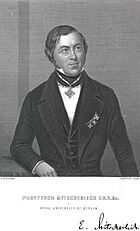
- Eilhard Mitscherlich (1794–1863) was a chemist. He discovered how some crystals have similar shapes.
- Erhard Milch (1892–1972) was a field marshal who helped develop the German air force.
- Hans Clarin (1929–2005) was an actor. He was known for voicing characters in children's audio plays.
- Karl Leister (born 1937) is a clarinet player. He played with the Berlin Philharmonic Orchestra.
- Thomas Hengelbrock (born 1958) is a violinist and conductor.
- Sebastian Polter (born 1991) is a soccer player.
- Kai Pröger (born 1992) is also a soccer player.
Sister Cities
Wilhelmshaven has special connections with other cities around the world. These are called sister cities:
 Vichy, France (since 1965)
Vichy, France (since 1965) Norfolk, Virginia, United States (since 1976)
Norfolk, Virginia, United States (since 1976) Dunfermline, Scotland, United Kingdom (since 1979)
Dunfermline, Scotland, United Kingdom (since 1979) Bromberg, Austria (since 1980)
Bromberg, Austria (since 1980) Bydgoszcz, Poland (since 2006)
Bydgoszcz, Poland (since 2006)
See also
 In Spanish: Wilhelmshaven para niños
In Spanish: Wilhelmshaven para niños



